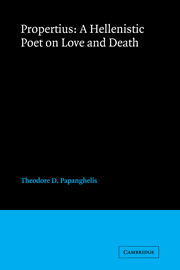Book contents
- Frontmatter
- Contents
- Preface
- Abbreviations
- 1 Introductory
- 2 nostris puer haesit ocellis: the lessons of 1.19
- 3 in amore mori: witches and lovers
- 4 in amore mori: the funeral
- 5 in amore mori: the shipwreck
- 6 in amore mori: crime passionnel
- 7 in amore mori: minor instances in Book 2
- 8 Strange beauty: a reading of 4.7
- 9 Concluding thoughts
- Bibliography
- Indexes
7 - in amore mori: minor instances in Book 2
Published online by Cambridge University Press: 04 August 2010
- Frontmatter
- Contents
- Preface
- Abbreviations
- 1 Introductory
- 2 nostris puer haesit ocellis: the lessons of 1.19
- 3 in amore mori: witches and lovers
- 4 in amore mori: the funeral
- 5 in amore mori: the shipwreck
- 6 in amore mori: crime passionnel
- 7 in amore mori: minor instances in Book 2
- 8 Strange beauty: a reading of 4.7
- 9 Concluding thoughts
- Bibliography
- Indexes
Summary
A word must be spared in this chapter for poems 9, 17, 20 and 24b of Book 2. Two points can be immediately made about them. First, although by comparison with the poems dealt with so far the interaction within them of the themes of love and death is rather low-key and conventional, it can still be seen to entail the conceptual and pictorial ingredients of, and constitute the major precondition for the far more original enterprises of, poems 8, 13 and 26b in particular. Secondly, despite the textual and interpretational problems that beset all but one (20), their thematic organisation and structural pattern clearly allies them with the same group of poems. No detailed treatment of all the issues involved is possible within the limits of this work, so I shall confine myself to a brief discussion of the interrelated questions of their structure and Liebestod in much the same way as I have done with the poems of the previous chapters. The discussion will permit some final remarks on the form of the poems of both groups and, I hope, will also warrant one or two points concerning the structure and unity of Book 2 as a whole.
In 2.9.1–36 Propertius contrasts his fickle mistress with the proverbially faithful Penelope (3–8) and – in a passage that betrays the influence both of a later sentimental tale and of a painting inspired by it (p. 130 above) – with Briseis dutifully tending the corpse of Achilles (9–16). The source of the trouble is identified in the very first couplet as a rival enjoying temporary favours soon to be withdrawn and transferred to another.
- Type
- Chapter
- Information
- Propertius: A Hellenistic Poet on Love and Death , pp. 133 - 144Publisher: Cambridge University PressPrint publication year: 1987



